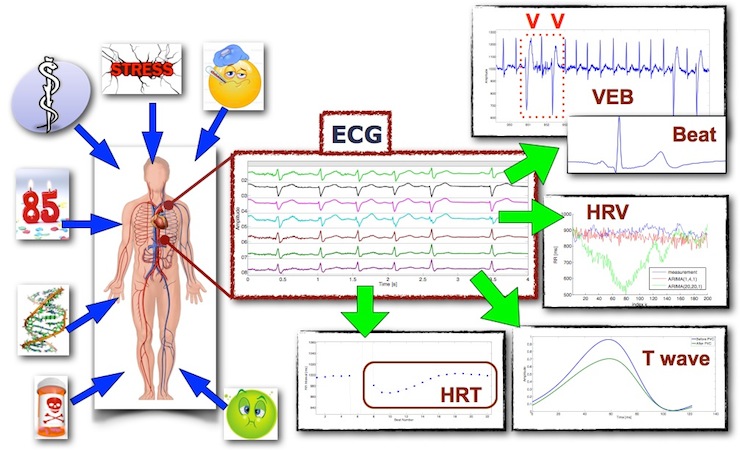Analysis of rhythmical and morphological properties of the ECG to detect cardiac abnormalities
- Ansprechperson:
- Projektgruppe:
Medizinische Messtechnik, Digitale Signalverarbeitung
Ectopic beats are together with atrial fibrillation the most common cause of cardiac arrhythmias. These arrhythmias can occur on healthy subjects but normally are related to heart diseases. The 12 standard ECG leads are the usual way of diagnosing these cardiac abnormalities. In addition, there are other methods like the analysis of the RR and QT time series, the morphological variations of the ECG waves and the heart rate turbulence, that are highly relevant research topics.
The 12 standard ECG leads are the usual way of diagnosing these cardiac abnormalities. In addition, there are other methods like the analysis of the RR and QT time series, the morphological variations of the ECG waves and the heart rate turbulence, that are highly relevant research topics.
The goal of this research project is the analysis of the surface ECG using innovative methods of signal processing, system theory, estimation theory, statistics machine learning in order to investigate the effects of external factors (diseases, medicine and physical stress) on the heart. These factors modify the normal rhythmical and morphological properties of the heart and can be used to diagnose a patient. Specially interesting for this research project are the ventricular ectopic beats. Such ectopic beats have their origin in the ventricles and can trigger tachycardia. They also generate short time fluctuations in the normal sinus rhythm of the heart (heart rate turbulence). This information can be used to estimate the risk of sudden cardiac death in a patient with a history of cardiac infarction. Modeling and simulation of those ectopic beats should help understand what physiological processes occur during such an event.
This project profits from its partners at other universities and hospitals that provide the medical studies for investigation. Furthermore, it is possible to run electrocardiographic studies with our cooperation partners.
Publications:
- Ectopic beats and their influence on the morphology of subsequent waves in the electrocardiogram. In Biomedical Engineering / Biomedizinische Technik, 2013.
- Removing ventricular far-field signals in intracardiac electrograms during stable atrial tachycardia using periodic component analysis. In Journal of Electrocardiology 2015

